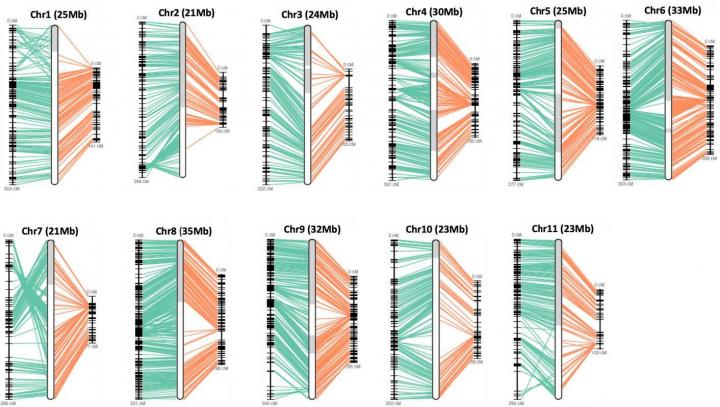Japan
June 16, 2020

The complete genome sequence of the bitter gourd and 11 chromosome maps revealed in this study. - Credit: Hideo Matsumura, Gene Research Center, Shinshu University
The bitter gourd (Momordica charantia) is a summer vegetable that graces the tables of many homes and restaurants in Asia. In Okinawa and Kyushu, the southern islands of Japan, the bitter gourds grow easily and have long been said to have many health benefits. The bitter gourds are packed with vitamin C, vitamin A, folate, minerals, carotenes and catechins. It is thought to ward off the feeling of sluggishness that can accompany the summer heat and humidity.
The bitter gourd is healthy to eat, and is traditionally said to have medicinal properties. There has been research into its effectiveness in lowering blood sugar. Associate Professor Hideo Matsumura of Shinshu University and an international team elucidated the genome sequence of the bitter gourd to scientifically look into developing strains that exhibit the medicinal claims and create a better product. Historically, it has been cultivated for the unique bitter taste preferred by the region, but demand is growing for a better universal product. For that purpose, it was necessary to clarify the genetic background of the bitter gourd.
Domestication occurs when humans actively modify traits of organisms. Most domesticated plants show the significant phenotypic and genotypic differences from wild strains upon the divergence between wild and cultivar groups. However, the bitter gourd showed its divergence after it had domesticated when regional cultivar groups reflected consumer preferences in different areas, to the South Asia and Southeast Asia type.
The group sequenced the genome of 60 bitter gourd strains: 18 wild accessions, 42 cultivar strains and an outgroup (Momordica cochinchinensis) from around the world. This process of sequencing and comparisons revealed that the bitter gourd came from the wild strain in South Asia 6000 years ago. Then, the Southeastern strain diverged from the South Asian cultivar strain 800 years ago, creating the large phenotypic divergence.
Two-stage patterns of quantitative trait evolution has also been observed in maize, watermelon and tomato. However, the bitter gourd may provide a valuable nonclassic model of domestication of the intermittent weaker selection and polygenic genetic architecture that precludes the identification of strong single candidate genes. Also, according to the low divergence between the wild and cultivars in the genomic region containing gynoecious locus, directional artificial selection for sex ratio cannot overwhelm the force of balancing selection in nature.
This study is also unique in that the group reported on the chromosome-level genome assembly and genomic investigation of non-classic domestication model instead of the usual selective sweep of newly mutated Mendelian genes.
This was a joint effort of researchers from Shinshu University, National Taiwan University, National Institute of Genetics, Japan, Okinawa Prefectural Agricultural Research Center, World Vegetable Center.
Data deposition: The assembled genome is available under DNA Data Bank of Japan, accession nos. BLBB01000001-BLBB01000193. The PacBio reads were submitted under DNA Data Bank of Japan, accession no. DRA009109. The Illumina reads of the OHB3-1 genome accession was submitted under DNA Data Bank of Japan, accession no. DRA009106 . Population resequencing Illumina reads were submitted under NCBI BioProject PRJNA578358.